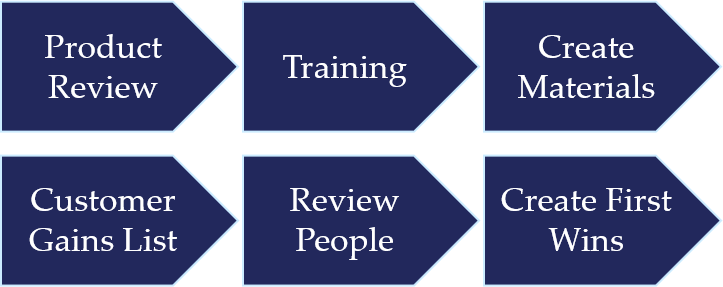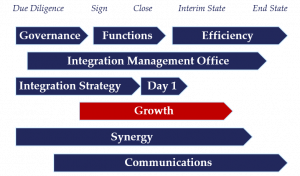To ensure enhanced growth from Day 1, sales and marketing plans must be in place. This requires a detailed understanding of how the businesses are operating currently and how the new sales and marketing areas need to operate in the future. Customer analysis avoids issues from customer overlap, potential customer losses, identify cross sell and up sell opportunities, plan the customer experience and ensure portfolio growth. Product analysis identifies opportunities for margin and revenue improvement through cost/pricing strategy and new product development. There is often chaos in the fragmented sales forces. Review and restructure of sales force, support, process CRM systems and data and the sales order process should be done rapidly. and sales support restructuring.


Often as external people hear of the heal they will try to figure out what it means from them and can come to the wrong conclusions, causing a drop in sales or future issues. A rapid review of the marketing strategy and external relationships, such as: channels, alliances, & partnerships, a brand review, understanding market share and new potential markets. This leads through to an assessment of how competitor may act and our response. Finally ensuring that communications are in place for all aspects in a timely manner, linking with the people and technology parts of the integration and ensuring that all the synergies are being delivered on time to cost.Often as external people hear of the heal they will try to figure out what it means from them and can come to the wrong conclusions, causing a drop in sales or future issues. A rapid review of the marketing strategy and external relationships, such as: channels, alliances, & partnerships, a brand review, understanding market share and new potential markets. This leads through to an assessment of how competitor may act and our response. Finally ensuring that communications are in place for all aspects in a timely manner, linking with the people and technology parts of the integration and ensuring that all the synergies are being delivered on time to cost.
Day 1
Day 1 is a critical part of the integration requiring clear focus on essential deliverables, communication with all customers, sales people and anyone who “touches the customer”, ensuring uninterrupted interfaces, They will be concerned about the impact on their own businesses. Everyone must be clear on what is being deliver and when. Functions such as Finance, HR, IT have to ensure that systems run, adequate support is in place. Process and people may change but the customer view must be seamless.
Portfolio Growth
A review of our customer and product base to fully understand where we can leverage our new entity. Where are there small customers that might grow rapidly over the coming years or customers we view as small due to their small spend with us but are in fact large spend customers and we could increase our percentage of their spend. This then leads to an implementation plan around the margin, and future potential of the customer as we see it. Will there be potential price changes. Up for unprofitable customers or volume discounts for large customers where we have a small share. Who will be the custodian of these high potential growth companies.
Customer Analysis
It is key to understand the customer base for both companies and their overlap. This leads to an understanding of what we should do with each customer, our segmentation and what competitors may do. Pulling customer lists together enable account management to be reviewed ready for Day 1 and overlap more fully understood. Chaos in our sales force will be bad and may create opportunity for competitors. Data around customer size, profitability, location, sector, future growth in profitability, suppliers, partners, products purchased, price, divisional contacts, who owns the customers (S&M or operations) what is the politics, should be analysed to provide insight in our strategy. We put plans in place for the interim state and head as rapidly as possible to our desired end state. This customer segmentation and analysis will lead into Day 1 communications plans which not only save “at risk” customers but start to kick off our cross & up sell plans. Reviewing margin enables us to put strategies in place for unprofitable customers and ensure sales force incentivisation links well with temporary or permanent changes. Can we see all customer touch points? Do we maximise revenue and profit through all of these? Do we know the amount of money we want to spend on each customer type?
Customer Retention
Develop customer communication and retention plans, including identification of owners of key customer relationships. Which type of customer are growing or shrinking? Can we improve customer service, loyalty, lifetime value or profitability?
Customer Experience
Many customers will question what is going to happen to them, will they continue to receive the service they have been receiving. Was that good enough. There is the opportunity to plan a continued good experience and show improvement to customers that have been unhappy. Understanding how all customers currently see us and feel about us, then planning for how they should see and feel us across Day 1, our interim states and end state. Remembering that these customers may speak with other customer, suppliers and people in our organisation who are not just sales and so may get a different feel from different people. They will also gather information and often misconceptions come from competitor sales people.
Cross Sell and up sell
This is often spoken about but not delivered, and then the deal fails to deliver what was hoped for. This is about detailed plans for cross sell and up sell. There is a specific chunk of analysis work to review customers and products enabling full lists with the potential growth. The pieces need to be put in place to then enable that growth to happen, reviewing and upskilling the people, training them on combined entity products, creating the marketing literature to enable sales to do the selling and finally ensure that people actually want to do all this extra selling – what is in it for the person – more work but more money. Once everything is in place the growth needs a little helping hand and we try to create the first wins, giving something for the rest to follow and flowing into our internal and external growth communications plan.


Action Lists often include:
- First few weeks/months, sales teams stay as they are, selling what they are selling
- Run selection process for people
- Sales teams and management
- Marketing teams and management (note products and mis-forecast), note timing before product range or after
- Restructure areas and teams, where needed
- Teach ranges to teams through training – get to know you sessions
- Get new product literature to sales teams
- Get incentivisation and bonuses right and out rapidly
- Get IT out fast (laptops, phones, enablers) – this sends a message
- Stop sandbagging, get formal letters out from HR
- Protect your customer lists, and be ready for competitor attacks and lies
Customer Experience
Many customers will question what is going to happen to them, will they continue to receive the service they have been receiving. Was that good enough? Do we want to improve anything?
There is the opportunity to plan a continued good experience and show improvement to customers that have been unhappy.
Understanding how all customers currently see us and feel about us, then planning for how they should see and feel us across Day 1, our interim states and end state.
Remembering that these customers may speak with other customer, suppliers and people in our organisation who are not just sales and so may get a different feel from different people.
They will also gather information and often misconceptions come from competitor sales people.
How to manager sales orders
A specific part of sales support to highlight is the sales order process. Do the sales people and customers of the newly acquired company know how to order? New sales can fall at the first hurdle. There is often some confusion around how to order products. This may be internally form the sales people, account managers, technical people. This may come from the customers not being sure what is going on. It could be some confusion in the telesales department around what is changing and when. Alternatively this confusion can be generated by competitors. The currently sales order process should be reviewed, this is more complex if we have a number of different way of doing this. Often were we have products and services, across divisions and geographies or have individual products and bundles this can be substantially more complex. Given there may be differences across organisations we must be clear from Day 1 to all how this will work in the interim state and what the end state will be. Check that call centre integration plans consistent with S&M plans.
Sales force Structure
There may be internal competition between different parts of the organisation for power, budgets, bonus, sales and customer ownership.
Clear and fast understanding of where all the customers are and who owns them is key. There is often a need to restructure the sales force in some manner and communicate this speedily.
Does the sales force believe what your telling them, do all your actions across in the integration re-inforce what your doing here or are there conflicts.
Review customers and their segmentation, design an appropriate sales force for future targets and everything that supports them from systems, and process to people and literature.
Develop customer opportunity plans, compensation plans and new territories and targets. Rolling out training for products and cross-sell and upsell plans. Whilst keeping everyone motivated.


Sales Support
As the sales force, products or customers and other parts of our organisation change – so the sales support people, process and systems may also change. Reviewing sales support fully to ensure, our company continues to be able to move forward is key.
Product Analysis
Again a full review of the overall new product and services list with volume, margin, etc. This work will be essential for the customer end of the growth model but will also enable us to look back into the organisation (a supply chain review) and see what changes and efficiencies can be made to increase our margin by product. We collect future projections from product managers, remembering these may be biased if we have not yet done our HR reorganisation. Tying this data to the historic sales and future changes in Sales and Marketing, we can understand which products we will be selling and how this fits with the new brand structure. Analyse products and services of both companies and develop a plan to eliminate redundancies and rationalize the range. Product changes may disrupt customers and needs to fit with the customer review and communications, as well as changing product based people may affect customer relationships.
Pricing
There is a close link with growth and profit, but also sales volume and sales person bonus. This links through to the people side of the deal as well as the financial aspects. Analyse pricing strategies of both companies and develop a plan to achieve alignment of pricing strategies.
New Product Development (NPD)
As part of the product review we need to more fully understand the NPD pipeline, cost to get to market and speed, so we can understand how this fits with the current product range. The two companies NPD departments need to be reviewed with regard to how they will work, budgets and the integration
Marketing Strategy
The Marketing strategy should be reviewed and updated, inline with the new aims. Specifically addressing the time depended key issues link product literature that will be needed by the sales people. Assess S&M organization, management structure and determine size needed to hit revenue forecasts.
Brand review
A review of the brand and sub-brands what they currently mean and where we would like to position them in the future. For both companies we could review the brand position, opportunities, benefits, messages, range support and what customer think. Then as we have done in Integration Strategy for other parts of the business decide what our end state will be and head there.
Review External Relationships
There may be overlap or confusion across the external parties we work with to aid sales. This may cover distributors, alliances, partnerships and channels to market. A full review to understand how these currently work and contracts in place, what we may what this all to look like in the future and how we might move to that. There can be large differences in how our two companies are perceived and this usually needs to be addressed rapidly. Analyse both companies distribution channels and develop a plan for consolidation. Develop communication and retention plans for key channel partners. Identify cross-selling opportunities through distribution channels of both companies.
Market share
There may be new markets opening up due to the merger, understanding our strengths and weaknesses, barriers to entry, timing, competitors, will help enable timely movement.
Communications
With sales and marketing plans in place, the communications plans need to be created. Communication channels to all employee and customers developed checked and activated. Communication guidelines detailing how (medium), what (consistent script and Q&As) and who will deliver the message as well as feedback process. Communications are about retaining people and customers, growth in appropriate areas, reducing uncertainty, delivering the business day to day and changes to it, ensuring success on Day 1, Day 180 and beyond.
Competitor response
There are many outside factors to think about, one is specifically our competitors. Responses will range from well thought through plans of attack though to random acts where sales people will “make stuff up”. In some deals the way competitors act can cause us to plan and run things much faster. The uncertainty can enable stealing our people to creating customer unrest or killing new sales. Review, plan and ensure we are ready. Compare competitors business strategy, product, service offerings, licensing models, marketing approaches, sales support, organization structure, compensation. Estimate potential competitive moves, develop early response mechanism to potential competitive moves, evaluate strategic alternatives
Synergy Analysis
Synergies can be identified, high level values developed and allocated to streams (function, divisions, businesses and countries). Delivery of synergy projects can be complex and you must understand how early decisions affect them longer term. Therefore, a robust and accurate tracking and reporting process for actions and sales. To support this a constant review of potential additional synergies should be part of the framework. Synergies may include, shared branding, advertising, promotion, channels, sales force, field marketing, service network, order processing, cross-selling, up-selling and pricing adjustments. These will tie in with the overarching Synergy Process:


Customer Overlap & Bids
Review customer overlap early, and understand how this should be handled both internally and through all customer facing/customer touching departments.
Review bids currently outstanding where the two organisations might be completing in the near future. Put a temporary process in place to ensure the bidding process does not create competition within the new group. Whilst a more permanent solution is defined and implemented.
Summary: M&A Integration Growth (Sales & Marketing)
The key is to minimise losses of people, customers, revenue and margin whilst maximising the potential. Most companies don’t think about this, plan at a high level or in any detail and so don’t create the value. There are a number of large chunks of work to be done. Plan Day 1, customer experience, customer analysis, Cross sell and up sell, analyse portfolio growth potential and plan its delivery. Ensure sales orders can happen and review sales support. Decide on Sales force size, structure, incentives and training. Review Product range, pricing strategies, margin and new product development. Review marketing strategy, brand, market share, external relationships, channels, alliances, partners, distributors. Ensure communications tie up with everything else and messages are consistent. Understand what the competition will do and plan for this. Plan and deliver synergies. Once everything is in place, monitor effectiveness of combined sales force, check alignment of sales force incentives with growth objectives, identify opportunities to further expand product portfolio, continue to track and monitor realization of revenue and growth objectives, continuously monitor channel effectiveness and customer retention.


